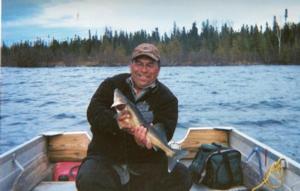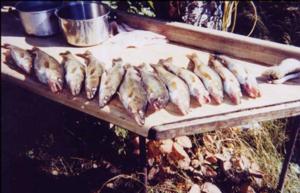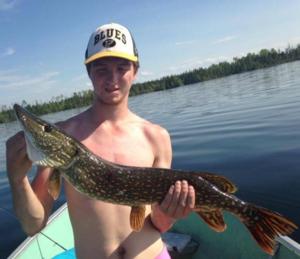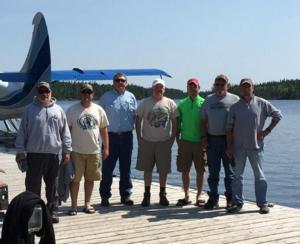
Ontario Walleye Fishing - Ontario Fly In Walleye Fishing
Ontario is the top destination in North America for walleye fishing and the lakes north of Nakina are the very best hot spots for walleyes in the province. There are no other lakes that produce such extremely high numbers of walleyes while still giving you the opportunity to catch trophy walleyes as well as good numbers of trout and pike. Using light jigs with a white twister tail and a piece of worm, Walleye gullet, leech, live minnow, or salted minnow works best. This is the most popular way to catch high numbers of Walleyes
The smaller inland lakes of Nakina also produce the best-tasting Walleyes, which are far superior in taste and color to suspended big-water Walleyes that feed on fishy Lake Herring.
After the day is done, don't forget to try our Walleye Recipes.

Ontario Fly In Fishing Lakes
Thanks to the conservation attitude of fishermen and better overall fisheries management in Ontario, every year the Walleye fishing keeps getting better and better. Our top Walleye lakes for numbers are our fly-in lakes. Ara Lake Lodge, Marshall Lake, and Dusey Lake Outpost Camp, which is a widening of the Dusey River, and Teabeau Lake, which is a widening of the Albany River, all produce incredible numbers as well as trophies. From ice-out in May to mid-July you can experience non-stop action. Many guests report back to us saying they found multiple places on the lakes where the Walleyes were schooling and they were catching one Walleye after another until their arms became sore. If you really wanted to you could catch 100 walleyes in a day.
Walleyes in our fly-in lakes are very common in the 1 to 3-pound range. You should catch a few in the 4 to 5-pound range during the day. Mid-spring before the big females go deep, you should catch a few in the 25 to 28-inch range and you can sacrifice numbers and try to fish deeper for 28 to 30-inch Walleyes. In the heat of summer, the 1 to 3-pound Walleyes are still the most common. Trolling close to shore at dusk and at night should produce a few Walleyes over 30 inches. On occasion, Walleyes in the 10 to 18-pound range are caught and released at our fly-in fishing lodges and Outpost camps.

Seasonal Canadian Walleye Fishing
Right after ice-out until the first week in June, 95% of the Walleyes will be caught within 10 feet of shore or in river current. The Walleyes are either spawning or just finished spawning. When the Walleyes are finished spawning, the really big females will go deeper but the small females and most of the males will still stay close to shore around the spawning beds. Wherever you see sand or current, there is a good chance the Walleyes were spawning there.
As the water warms up, the Walleyes leave the shallows and go a little deeper. Around mid-June, the Walleyes go back to their usual feeding patterns at their regular feeding areas. Mid-June to mid-July; the Walleyes still school and can be found off rocky points, shoals, islands, and along weed lines. They will be a little deeper and primarily in the 4 to 10-foot range. It might take a little time to find where they are schooling if you have never fished the lake before. Once you find them, it's non-stop action.
During the summer and fall, mid-July to ice-in, the Walleyes still school and can be found off rocky points, shoals, islands, and along weed lines. Fishing this time of year is a matter of preference. The smaller Walleyes slow down their feeding patterns so you will not get the extremely high numbers, with the exception of rainy or windy days. This is also the time of year when the big trophy female Walleyes no longer have cold water in the deep to slow down their metabolism so they start coming into the shallows to feed. Some of the biggest Walleyes in Ontario have been caught in the heat of August. The big females don't start feeding until dusk and will keep feeding all night long. If you want to catch multiple Walleyes in the 25 to 34-inch range, night fishing is your ticket. We will describe this in detail on our Walleye fishing tips page.

Base Camp on Lower Twin Lake, Ontario
The Walleye fishing at our drive-to base camp is great. You will not see the numbers that you will see on a fly-in but you will see the same sizes and most certainly catch enough Walleyes to be happy. Pete's Bay is the major Walleye Spawning area for Upper & Lower Twin Lakes and a Provincial Fish Sanctuary, which translates into Walleye Producing Machine. In early spring and late fall, some of the biggest Walleyes in the Nakina area are found in the Drowning River, which in part flows from Upper Twin Lake and Lower Twin. Walleyes in the Twin Lakes are generally caught a couple of feet deeper because the water is clearer than the fly-in lake. Be equipped to fish in the 8 to 12-foot range. Each year, many walleye in the 26" - 30" range are caught here, as well as 25lb Pike.

Walleye Fishing Tips
There are different walleye fishing scenarios. You can go for numbers or you can go for size. Some guests are happy to find a hotspot off a shoal or rocky point and catch Walleyes after Walleye all day. Guests who have experienced this type of action before tend to take a little time out and try down deeper or fish more at night for the monster-sized trophy females that come shallow when the sun goes down. The tips below cover different types of Walleye fishing.
Please Note: Fish in the north avoid artificial scents. Use unscented rubbers and do not put scent on your lures. Wash your lures before you head north if you have ever used artificial scents. Salted grubs work great!
.jpg)
Catching A Lot Of Walleyes
In the spring, Walleyes are either in a river current or right close to shore. When I say close to shore, I mean 3 to 10 feet from shore. In Northern Ontario Canadian Shield Lakes, the Walleyes that don't spawn in the river will find sandy areas along the shore to spawn. By the time fishing season opens, most Walleyes are finished spawning but they will hang around to protect their spawning beds.
You can put on a light jig (1/8th or 1/16th oz) and cast along the shore and retrieve it quite aggressively as the Walleyes are very aggressive this time of year. Use bright colors like red, chartreuse, yellow, or white. Walleyes that are feeding will hit the jig. Walleyes that are not feeding will still hit bright colors because they are defending the spawning grounds and bright colors aggravate them. Generally, white is always the best color.
In the daytime and in early spring, you will most likely catch smaller males, which stay at the spawning beds. The bigger females usually take off into deeper water during the day. If you are going after size instead of numbers, fish off the areas where Walleyes were spawning and fish deeper in the 10 to 15-foot depth. That's where the big females are.
How do you find that special spot along the shore where the Walleyes are congregating? In the spring, put on a small Original Floating Rapala or Thunderstick and troll really slow right along the shoreline. The Walleyes will be in 2 to 4 feet of water. Red, Blue, Chartreuse, and Fire tiger are the best colors in the spring. If you keep trolling past a spot and hit Walleyes, then that's where they are. In this case, stop the motor and start casing. Trolling back and forth too many times will spook the area and they will stop feeding.
A few years ago in very early spring (just after the ice-out), we fished right along the shore at Dusey Lake. If we were more than 10 feet away from shore; we would not catch anything. Across the lake was a bunch of guys that were staying in a different camp. They watched us fishing along the shore and catching Walleye after Walleye. They were fishing out in the middle of the lake and catching nothing. They watched us catch fish all day. We told them the Walleyes were right on shore yet they would not listen and fished out in the middle of the lake and continued to catch nothing.
If you are going to be a stubborn fisherman who never tries anything new or will not accept the fact that the fishing in Northern Ontario is different than down south, then all you'll catch is disappointment. In early spring, 95% of the walleyes will be in water shallower than 5 feet. In the afternoon, the big females will go deeper to protect themselves from the sun and Pike.
.jpg)
Ontario Summer Fishing Tips
In the summer the walleyes go a little deeper, hang out at the mouth of rivers, or lay off rocky points. Islands that have patches of gravel around them are good spots. Rocky drop-offs are also good. With lakes that have a flat structure, the Walleyes will head into the thick weeds to get protection from the sun.
In the summer, Walleyes tend to go after more natural colors like silver, brown, black, and white. When fishing with jigs, you can go to a heavier jig like a 3/8-oz or even 1/4-oz depending on how deep you are fishing. The unscented twister tails or rubber you put on the jig should be these natural colors. Fish in the north do not like scented rubbers. They do like salted rubbers. Live minnows, if allowed, are excellent whether on a jig or just a strait hook. If you are on a lake where you cannot use live bait, get some salted minnows. We catch minnows and then cure them with salt. It seems a little cruel but it's convenient and the Walleyes go nuts over them. Just put a bunch of minnows on a cookie sheet and cover them with a generous amount of table salt.
.jpg)
Walleye Fishing on Hot Summer Days in Ontario
Sometimes the Walleyes get very lazy in the summer, especially if it's a hot sunny day. Use a 1/8-oz jig and put a white unscented twistertail on. Then cast out and literally drag the jig across the bottom. Give it tiny little jigs (2 or 3 inches) once in a while just to shake off any mud or weeds. This bottom dragging gets the Walleyes feeding. It really works. You should always jig slowly. Just make the jig motion longer in the morning, as the Walleyes are more aggressive. Sharp quick jigs will attract pike. In the afternoon when the Walleyes slow down, put a piece of worm, Walleye gullet, or salted minnow on your jig and use the slow bottom drag method and you will start hitting Walleyes again.
Trolling off the rocky points with a Rapala or Thunderstick is also good in the summer. Natural colors like silver or brown seem to work best. If you use bright colors, you will hit tons of pike. In the summer, the Walleyes tend to go a little deeper and stay off rocky points or rocky drop-offs because wave action on the rocks creates more oxygen. Also, bugs and other food floating on the surface tend to get denser when drifting past a point so small minnows show up to feed, and the Walleyes feed on the minnows.
.jpg)
Fall Walleye Fishing Techniques
Fishing in the fall for Walleyes can be very frustrating. What happens in many lakes is the water cools down and the weeds start to die. As the weeds die, they absorb oxygen out of the water and then decompose. Dead weeds also produce a dirty methane-sulfate and when the methane bubbles are released and float to the surface, the molecule captures a hydrogen molecule and releases the sulfur, which is poison to fish in high concentrations but with trace amounts, it's annoying to them. The Walleyes take off into open water or up rivers and away from the dying weeds. They may move to the outer edge of big weed beds where the prevailing winds are blowing fresh water into the weeds.
.jpg)
River Fishing
The Walleyes will swim upstream and hang around deep pools or back-moving currents on either side of the rapids. When fishing in a river for Walleyes, the best thing to use is a float with a minnow or a worm. You can also cast Rapalas and Thundersticks and reel them in through the slower-moving current and back eddies. You can use jigs but you will get snagged many times and it can ruin your day.
Open Water Fishing
In the fall, many of the Walleyes go out into open water and stay suspended. Generally (not always) they tend to stay in 10 to 25 feet of water. Many fishermen like to troll with the Rapala "Down Deep Husky Jerks" and the Rattling Fat Raps. This is not the most exciting type of fishing but it's better than nothing. If you are in an area where there is a good population of Walleyes, you should catch them. You will need a depth finder and see where you are marking fish. The atmospheric pressure will affect what depth the Walleyes are at. If the pressure goes really low, the walleyes may stop feeding altogether. BUT…if the pressure starts rising, the Walleyes will start feeding and aggressively. Walleyes always feed the best when the pressure is on the rise.
.jpg)
How to catch big Trophy Walleyes
Big trophy Walleyes are usually deep during the day and come up into shallow water at night to hunt down minnows along the shore.
Big Deep-Water Walleyes
In the heat of the summer, most big Walleyes, especially the big females, will go deep and stay down between 15 and 35 feet deep. They only come to shore at night. During the day, they will move out into open water and feed on suspended schools of lake shad and Lake Herring. This is especially true in lakes where the shoreline is a gauntlet of Pike teeth. They will also stay right on the bottom and hang around large rocks or deep weeds on the bottom of the lake.
There are two things you can do. If you are in a bigger boat you can use downriggers or use down-deep Husky Jerks or J-13 down deep jointed Rapalas and troll out in open water. Look for schools of baitfish 20 to 40 yards off rocky points or river mouths. Try fishing 15 to 35 feet deep.
If you are in a small boat and you can troll really slow, use a 3-way swivel and a 1 or 2-oz weight and back-troll through the schools of baitfish or troll 20 feet deep along the shore and follow the contours of the shoreline. Use a worm harness with a big juicy worm or a small floating Rapala.
At night in the fall: Some of the really big females will come in close to shore at night, especially in the fall or late summer. Between 10:00 PM and 3:00 AM, try trolling with an Original Floating Rapala along the shore in 2 or 3 feet of water or troll past rocky shoals. You can also troll along patches of thick weeds out in the lake. The prime areas are where there are lots of minnows but lack protection from the sun during the day. For some reason, blue is the magic color for fishing along the shore at night in summer and late fall. In the spring you can use other colors like Fire-Tiger, Red, or Chartreuse. You have to troll your boat very slowly and you have to be quiet. In the evening and at night, the biggest Walleyes are feeding.
.jpg)
The Loten Walleye Rig
Another fantastic way to fish deep and make sure you are right on the bottom is by using a Loten Floating Jig Rig. This rig is named after Greg Loten, who was a professional fishing guide and commercial bush plane pilot in Ontario's far north for many years. He was well known for catching monster-size Walleyes in lakes that are not known for large Walleyes.
The Loten Rig has elements of a Little Joe rig and is also similar to a Lindy Rig. You need a floating jig head, a big fat dew-worm, a trailer hook on 2.5 inches of line, ½ oz slide-sinker, a small split shot sinker, and a clean syringe.
First, slide your slide-sinker down your line and then tie on the floating jig. Take your jig and put the hook into the end of the worm (head) and just far enough in so that you do not break the skin below the clitellum (see diagram below). Then put on a trailer hook on the jig's hook. Let the trailer hook dangle. Do not stick it in the tail of the worm. Do not break the skin on the bottom half of the worm. Then with a clean syringe, inject air into the tail of the worm. Don't stick the syringe into the worm at a 90-degree angle or the air leaks out. Try to penetrate the worm's skin at 45 degrees or less.
Before you tie your jig on the line, you are supposed to slide a slip-sinker onto the line. Then you put a small split shot sinker 3 to 4 feet down the line from the floating jig so your slip sinker does not slide any closer to the jig.
The rig can be used in any depth of water and any time of day but it seems to produce the biggest walleyes at night when closer to shore and bigger Walleyes during the day when fishing a little deeper.
To use the rig, just troll very slowly and give long slow jigs and let the sinker hit bottom or even drag bottom. The whole purpose of the rig is to keep your worm off the bottom but close to the bottom and be able to do long slow lazy jigs, which the bigger and less aggressive Walleyes seem to respond to. There are more 10-pound + Walleyes caught on this rig than any other rig. The prime time is ¼ hour after dark and right in close to shore. When you are jigging, just think that a big old fat Walleye that's out of breath is trying to catch up to it so jig smooth and slow.
Walleye Fishing photos at 7 Lakes Wilderness Camps.

































.jpg)

.jpg)

.jpg)

.jpg)

.jpg)

.jpg)


.jpg)

.jpg)

.jpg)


.jpg)

.jpg)
.jpg)

.jpg)
.jpg)
